The Overlooked Suspension Feeders: The Filtering Activity of the Bryozoans Schizoporella errata and Bugula neritina in the Northern Adriatic
Abstract
1. Introduction
2. Materials and Methods
2.1. Studied Species and the Study Area
2.2. Sampling of Bryozoans and Acclimatization
2.3. Experimental Setup
2.4. Measuring the Bryozoan Colonies from Both Experiments and Measuring of the Active Feeding Areas
2.5. Processing of Water Samples
2.6. Data Analysis
3. Results
3.1. Clearance Rates and Morphological Insights in S. errata and B. neritina
3.2. Microplastic Clearance Rates and Active Colony Regions in S. errata
4. Discussion
4.1. Comparison of CR in Bryozoan and Other Species
| Suborder | Species | Colony Form | No. az/cm2 | CR (mL/h) | % Active Zooids During Feeding | |||||
|---|---|---|---|---|---|---|---|---|---|---|
| per g DW (total) | per cm2 (total) | per zooid * | ||||||||
| active | total | NS | Theoretical # | |||||||
| Flustrina | Schizoporella errata | encrusting-erect | 575 a | 856 a | 32 and 49 a | 0.18 a | 0.05 and 0.09 a | 1.1–1.3 | 48 a | |
| Flustrina | Bugula neritina | erect | 535 a | 12,371 a | 521 | 0.10 a | 1.9–2.0 | |||
| Membraniporina | Arbocuspis bellula | encrusting | 1265 [21] | 9500 [21] | 34–56 [21] | 0.08 [21] | 0.42–0.50 | 49 [21] | ||
| Flustrina | Celleporella hyalina | encrusting | 0.12–0.17 [12] | 0.5 | 65 [16] | |||||
| Membraniporina | Conopeum reticulum | encrusting | 0.25–0.41 [15] | 0.42–0.46 | ||||||
| Membraniporina | Electra pilosa | encrusting-erect | 0.28 [16] | 0.20–0.39 [15] | 0.46–0.84 | 92 [16] | ||||
| Membraniporina | Membranipora membranacea | encrusting | 123 [20] | 0.36 [20] | 1.06 | |||||
| Vesicularina | Amathia verticillata | erect | 33,700 [14] | 0.37 [14] | 0.36 | |||||
4.2. Standardization of CR in Bryozoans
4.3. Active Colony Regions in S. errata and Feeding on Microplastic
5. Conclusions
Supplementary Materials
Author Contributions
Funding
Institutional Review Board Statement
Data Availability Statement
Acknowledgments
Conflicts of Interest
References
- Bulleri, F.; Chapman, M.G. The introduction of coastal infrastructure as a driver of change in marine environments. J. Appl. Ecol. 2010, 47, 26–35. [Google Scholar] [CrossRef]
- Layman, C.A.; Jud, Z.R.; Archer, S.K.; Riera, D. Provision of ecosystem services by human-made structures in a highly impacted estuary. Environ. Res. Lett. 2014, 9, 044009. [Google Scholar] [CrossRef]
- Cranford, P.J. Magnitude and extent of water clarification services provided by bivalve suspension feeding. In Goods and Services of Marine Bivalves; Smaal, A.C., Grant, J., Strand, Ø., Ferreira, J.G., Petersen, J.K., Eds.; Springer Open: Cham, Switzerland, 2019; pp. 119–142. [Google Scholar]
- Draughon, L.D.; Scarpa, J.; Hartmann, J.X. Are filtration rates for the rough tunicate Styela plicata independent of weight or size? J. Environ. Sci. Health A 2010, 45, 168–176. [Google Scholar] [CrossRef]
- Stabili, L.; Licciano, M.; Gravina, M.F.; Giangrande, A. Filtering activity on a pure culture of Vibrio alginolyticus by the solitary ascidian Styela plicata and the colonial ascidian Polyandrocarpa zorritensis: A potential service to improve microbiological seawater quality economically. Sci. Total Environ. 2016, 573, 11–18. [Google Scholar] [CrossRef]
- Clapin, G. The Filtration Rate, Oxygen Consumption and Biomass of the Introduced Polychaete Sabella spallanzanii Gmelin Within Cockburn Sound: Can It Control Phytoplankton Levels and Is It an Efficient Filter Feeder? Bachelor’s Thesis, Edith Cowan University, Joondalup, WA, Australia, 1996. [Google Scholar]
- Licciano, M.; Stabili, L.; Giangrande, A. Clearance rates of Sabella spallanzanii and Branchiomma luctuosum (Annelida: Polychaeta) on a pure culture of Vibrio alginolyticus. Water Res. 2005, 39, 4375–4384. [Google Scholar] [CrossRef] [PubMed]
- Stabili, L.; Schirosi, R.; Licciano, M.; Mola, E.; Giangrande, A. Bioremediation of bacteria in aquaculture waste using the polychaete Sabella spallanzanii. New Biotechnol. 2010, 27, 774–781. [Google Scholar] [CrossRef]
- Varamogianni-Mamatsi, D.; Anastasiou, T.I.; Vernadou, E.; Papandroulakis, N.; Kalogerakis, N.; Dailianis, T.; Mandalakis, M. A multi-species investigation of sponges’ filtering activity towards marine microalgae. Mar. Drugs 2022, 20, 24. [Google Scholar] [CrossRef]
- Stabili, L.; Licciano, M.; Giangrande, A.; Longo, C.; Mercurio, M.; Marzano, C.N.; Corriero, G. Filtering activity of Spongia officinalis var. adriatica (Schmidt) (Porifera, Demospongiae) on bacterioplankton: Implications for bioremediation of polluted seawater. Water Res. 2006, 40, 3083–3090. [Google Scholar] [CrossRef]
- Milanese, M.; Chelossi, E.; Manconi, R.; Sarà, A.; Sidri, M.; Pronzato, R. The marine sponge Chondrilla nucula Schmidt, 1862 as an elective candidate for bioremediation in integrated aquaculture. Biomol. Eng. 2003, 20, 363–368. [Google Scholar] [CrossRef]
- Riisgård, H.U.; Manríquez, P. Filter-feeding in fifteen marine ectoprocts (Bryozoa): Particle capture and water pumping. Mar. Ecol. Prog. Ser. 1997, 154, 223–239. [Google Scholar] [CrossRef]
- Lemmens, J.W.T.J.; Clapin, G.; Lavery, P.; Cary, J. Filtering capacity of seagrass meadows and other habitats of Cockburn Sound, western Australia. Mar. Ecol. Prog. Ser. 1996, 143, 187–200. [Google Scholar] [CrossRef][Green Version]
- Bullivant, J.S. The rate of feeding of the bryozoan, Zoobotryon verticillatum. N. Z. J. Mar. Freshw. Res. 1968, 2, 111–134. [Google Scholar] [CrossRef]
- Menon, N.R. Clearance rates of food suspension and food passage rates as a function of temperature in two north-sea bryozoans. Mar. Biol. 1974, 24, 65–67. [Google Scholar] [CrossRef]
- Riisgård, H.U.; Goldson, A. Minimal scaling of the lophophore filter-pump in ectoprocts (Bryozoa) excludes physiological regulation of filtration rate to nutritional needs. Test of hypothesis. Mar. Ecol. Prog. Ser. 1997, 156, 109–120. [Google Scholar] [CrossRef]
- Lisbjerg, D.; Petersen, J.K. Feeding activity, retention efficiency, and effects of temperature and particle concentration on clearance rate in the marine bryozoan Electra crustulenta. Mar. Ecol. Prog. Ser. 2001, 215, 133–141. [Google Scholar] [CrossRef]
- Pratt, M.C. Consequences of coloniality: Influence of colony form and size on feeding success in the bryozoan Membranipora membranacea. Mar. Ecol. Prog. Ser. 2005, 303, 153–165. [Google Scholar] [CrossRef]
- Pratt, M.C. Living where the flow is right: How flow affects feeding in bryozoans. Integr. Comp. Biol. 2008, 48, 808–822. [Google Scholar] [CrossRef]
- Pascoe, P.L.; Parry, H.E.; Hawkins, A.J.S. Dynamic filter-feeding responses in fouling organisms. Aquat. Biol. 2007, 1, 177–185. [Google Scholar] [CrossRef][Green Version]
- Lisbjerg, D.; Petersen, J.K. Clearance capacity of Electra bellula (Bryozoa) in seagrass meadows of western Australia. J. Exp. Mar. Biol. Ecol. 2000, 244, 285–296. [Google Scholar] [CrossRef]
- EASIN—European Alien Species Information Network, European Commission. Available online: https://easin.jrc.ec.europa.eu/easin (accessed on 8 January 2025).
- Bryan, P.J.; Kreider, J.L.; Qian, P.Y. Settlement of the serpulid polychaete Hydroides elegans (Haswell) on the arborescent bryozoan Bugula neritina (L.): Evidence of a chemically mediated relationship. J. Exp. Mar. Biol. Ecol. 1998, 220, 171–190. [Google Scholar] [CrossRef]
- Cocito, S.; Ferdeghini, F.; Morri, C.; Bianchi, N.B. Patterns of bioconstruction in the cheilostome bryozoan Schizoporella errata: The influence of hydrodynamics and associated biota. Mar. Ecol. Prog. Ser. 2000, 192, 153–161. [Google Scholar] [CrossRef]
- Morgado, E.H.; Tanaka, M.O. The macrofauna associated with the bryozoan Schizoporella errata in southeastern Brazil. Sci. Mar. 2001, 65, 173–181. [Google Scholar] [CrossRef]
- Sokolover, N.; Ostrovsky, A.N.; Ilan, M. Schizoporella errata (Bryozoa, Cheilostomata) in the mediterranean sea: Abundance, growth rate, and reproductive strategy. Mar. Biol. Res. 2018, 14, 868–882. [Google Scholar] [CrossRef]
- Hayward, P.J.; McKinney, F.K. Northern Adriatic Bryozoa from the vicinity of Rovinj, Croatia. Bull. Am. Mus. Nat. Hist. 2002, 270, 1–139. [Google Scholar] [CrossRef]
- Banta, W.C. The body wall of cheilostome Bryozoa, V. Frontal budding in Schizoporella unicornis floridana. Mar. Biol. 1972, 14, 63–71. [Google Scholar] [CrossRef]
- Nikolić, M. Polimorfna Rast Zoarijev Ektoproktne Vrste Schizoporella violacea Canu & Bassler 1930. Ph.D. Thesis, Univerza v Ljubljani, Rovinj, Croatia, 1959. [Google Scholar]
- Zabin, C.J.; Obernolte, R.; Mackie, J.A.; Gentry, J.; Harris, L.; Geller, J. A non-native bryozoan creates novel substrate on the mudflats in San Francisco Bay. Mar. Ecol. Prog. Ser. 2010, 412, 129–139. [Google Scholar] [CrossRef]
- Winston, J.E. Distribution and Ecology of Estuarine Ectoprocts: A Critical Review. Chesap. Sci. 1977, 18, 34–57. [Google Scholar] [CrossRef]
- Fehlauer-Ale, K.H.; Mackie, J.A.; Lim-Fong, G.E.; Ale, E.; Pie, M.R.; Waeschenbach, A. cryptic species in the cosmopolitan Bugula neritina complex (Bryozoa, Cheilostomata). Zool. Scr. 2013, 43, 193–205. [Google Scholar] [CrossRef]
- Ryland, J.S.; Hayward, P.J. British Anascan Bryozoans, Synopses of the British Fauna (New Series); Academic Press Inc.: London, UK; New York, YN, USA; San Francisco, CA, USA, 1977; Volume 10. [Google Scholar]
- Lord, J.P. Impact of seawater temperature on growth and recruitment of invasive fouling species at the global scale. Mar. Ecol. 2017, 38, e12404. [Google Scholar] [CrossRef]
- Kitamura, H.; Hirayama, K. Growth of the bryozoan Bugula neritina in the sea at various water temperatures. Bull. Jpn. Soc. Sci. Fish. 1984, 50, 1–5. [Google Scholar] [CrossRef]
- Fofonoff, P.W.; Ruiz, G.M.; Steves, B.; Simkanin, C.; Carlton, J.T. National Exotic Marine and Estuarine Species Information System. Available online: https://invasions.si.edu/nemesis/ (accessed on 30 April 2025).
- Boicourt, W.C.; Kuzmić, M.; Hopkins, T.S. The inland sea: Circulation of Chesapeake Bay and the northern Adriatic. In Ecosystems at the Land-Sea Margin: Drainage Basin to Coastal Sea; Malone, T.C., Malej, A., Harding, L.W., Jr., Smodlaka, N., Turner, R.E., Eds.; American Geophysical Union: Washington, DC, USA, 1999; pp. 81–129. [Google Scholar]
- Grilli, F.; Accoroni, S.; Acri, F.; Aubry, F.B.; Bergami, C.; Cabrini, M.; Campanelli, A.; Giani, M.; Guicciardi, S.; Marini, M.; et al. Seasonal and interannual trends of oceanographic parameters over 40 years in the northern Adriatic Sea in relation to nutrient loadings using the EMODnet Chemistry Data Portal. Water 2020, 12, 2280. [Google Scholar] [CrossRef]
- Ogorelec, B.; Mišič, M.; Faganeli, J. Marine geology of the Gulf of Trieste (northern Adriatic): Sedimentological aspects. Mar. Geol. 1991, 99, 79–92. [Google Scholar] [CrossRef]
- Turk, R. Ocena ranljivosti slovenskega obalnega pasu in njegova kategorizacija z vidika (ne)dopustnih posegov, dejavnosti in rabe. Ann. Ser. Hist. Nat. 1999, 9, 37–50. [Google Scholar]
- Okamura, B. The effects of ambient flow velocity, colony size, and upstream colonies on the feeding success of Bryozoa. I. Bugula stolonifera Ryland, an arborescent species. J. Exp. Mar. Biol. Ecol. 1984, 83, 179–193. [Google Scholar] [CrossRef]
- Mesečni Bilten ARSO, Slovenian Environment Agency. Available online: http://hmljn.arso.gov.si/o%20agenciji/knji%C5%BEnica/mese%C4%8Dni%20bilten/ (accessed on 22 January 2021).
- Rosa, M.; Ward, J.E.; Shumway, S.E.; Wikfors, G.H.; Pales-Espinosa, E.; Allam, B. Effects of particle surface properties on feeding selectivity in the eastern oyster Crassostrea virginica and the blue mussel Mytilus edulis. J. Exp. Mar. Biol. Ecol. 2013, 446, 320–327. [Google Scholar] [CrossRef]
- Abramoff, M.D.; Magalhaes, P.J.; Ram, S.J. Image processing with ImageJ. Biophotonics Int. 2004, 11, 36–42. [Google Scholar]
- Bankhead, P. Analyzing Fluorescence Microscopy Images with ImageJ; Heidelberg University: Heidelberg, Germany, 2014; p. 187. [Google Scholar]
- Chamberlin, J.F. Algal Wastewater Treatment and Biofuel Production: An Assessment of Measurement Methods, and Impact of Nutrient Availability and Species Composition. Ph.D. Thesis, University of Arkansas, Fayetteville, AR, USA, 2016. [Google Scholar]
- Randløv, A.; Riisgård, H.U. Efficiency of particle retention and filtration rate in four species of ascidians. Mar. Ecol. Prog. Ser. 1979, 1, 55–59. [Google Scholar] [CrossRef]
- Coughlan, J. The estimation of filtering rate from the clearance of suspensions. Mar. Biol. 1969, 2, 356–358. [Google Scholar] [CrossRef]
- Navarro, J.M.; Widdows, J. Feeding physiology of Cerastoderma edule in response to a wide range of seston concentrations. Mar. Ecol. Prog. Ser. 1997, 152, 175–186. [Google Scholar] [CrossRef]
- Widdows, J.; Staff, F. Biological Effects of Contaminants: Measurement of Scope for Growth in Mussels; International Council for the Exploration of the Sea: Copenhagen, Denmark, 2006; p. 40. [Google Scholar] [CrossRef]
- Echevarria, M.; Naar, J.P.; Tomas, C.; Pawlik, J.R. Effects of Karenia brevis on clearance rates and bioaccumulation of brevetoxins in benthic suspension feeding invertebrates. Aquat. Toxicol. 2012, 106, 85–94. [Google Scholar] [CrossRef]
- Fiala-Médioni, A. filter-feeding ethology of benthic invertebrates (Ascidians). IV. Pumping rate, filtration rate, filtration efficiency. Mar. Biol. 1978, 48, 243–249. [Google Scholar] [CrossRef]
- Hernandis, S.; Ibarrola, I.; Tena-Medialdea, J.; Albentosa, M.; Prado, P.; Vázquez-Luis, M.; García-March, J.R. Physiological responses of the fan mussel Pinna nobilis to temperature: Ecological and captivity implications. Mediterr. Mar. Sci. 2023, 24, 259–271. [Google Scholar] [CrossRef]
- Albentosa, M.; Akinyemi, M.I.; Vera, M.; Ibarrola, I.; Filgueira, R.; Galimany, E.; da Costa, F.; Pardo, B.G.; Vázquez-Luis, M.; Hernández, A.; et al. Recovery of eutrophized marine ecosystems using the European flat oyster, Ostrea edulis. Aquat. Conserv. 2023, 33, 645–660. [Google Scholar] [CrossRef]
- Strathmann, R. Function of lateral cilia in suspension feeding of lophophorates (Brachiopoda, Phoronida, Ectoprocta). Mar. Biol. 1973, 23, 129–136. [Google Scholar] [CrossRef]
- Winston, J.E. Bryozoans (Ectoprocta) of Indian River. Bull. Am. Mus. Nat. Hist. 1982, 173, 99–176. [Google Scholar]
- Okamura, B. Particle size and flow velocity induce an inferred switch in bryozoan suspension-feeding behavior. Biol. Bull. 1987, 173, 222–229. [Google Scholar] [CrossRef]
- Shunatova, N.N.; Ostrovsky, A.N. Individual autozooidal behaviour and feeding in marine bryozoans. Sarsia 2001, 86, 113–142. [Google Scholar] [CrossRef]
- Barnes, D.K.A.; Clarke, A. Seasonal variation in the feeding activity of four species of Antarctic bryozoan in relation to environmental factors. J. Exp. Mar. Biol. Ecol. 1994, 181, 117–133. [Google Scholar] [CrossRef]
- Barnes, D.K.A.; Clarke, A. Seasonality of polypide recycling and sexual reproduction in some erect Antarctic bryozoans. Mar. Biol. 1998, 131, 647–658. [Google Scholar] [CrossRef]
- Bock, P.E. Bryozoans (Phylum Bryozoa or Ectoprocta). In Marine Invertebrates of Southern Australia, Part I; Shepherd, S.A., Thomas, I.M., Eds.; South Australian Government: Adelaide, Australia, 1982; pp. 319–394. [Google Scholar]
- Okamura, B. Particle Size, Flow Velocity, and Suspension-Feeding by the Erect Bryozoans Bugula neritina and B. stolonifera. Mar. Biol. 1990, 53, 33–38. [Google Scholar] [CrossRef]
- Masiá, P.; Sol, D.; Ardura, A.; Laca, A.; Borrell, Y.J.; Dopico, E.; Laca, A.; Machado-Schiaffino, G.; Díaz, M.; Garcia-Vazquez, E. Bioremediation as a promising strategy for microplastics removal in wastewater treatment plants. Mar. Pollut. Bull. 2020, 156, 111252. [Google Scholar] [CrossRef] [PubMed]
- Rahman, S. A Risk Analysis of Microplastic Consumption in Filter Feeders. Master’s Thesis, Nova Southeastern University, Fort Lauderdale-Davie, FL, USA, 2019. [Google Scholar]


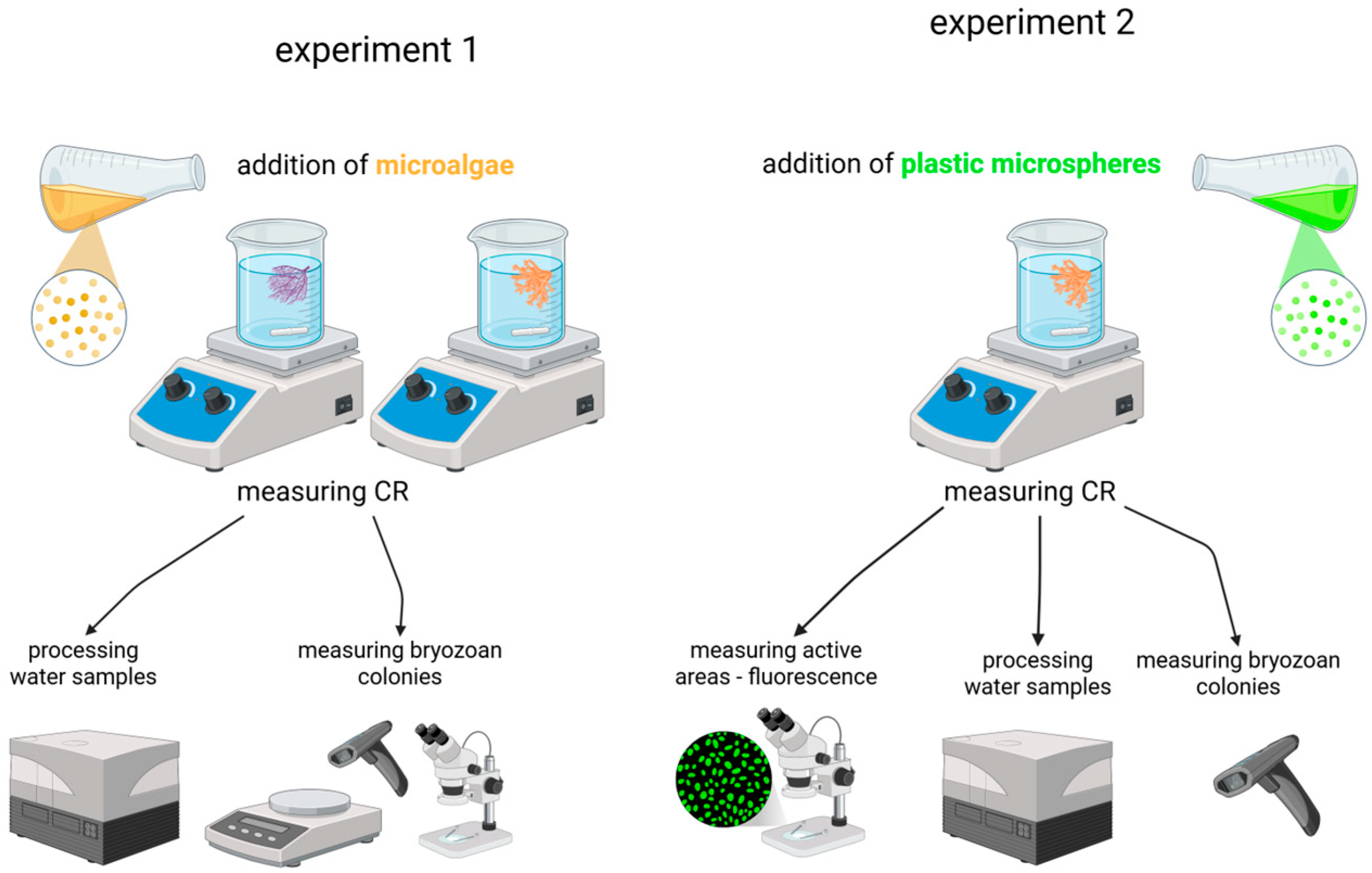
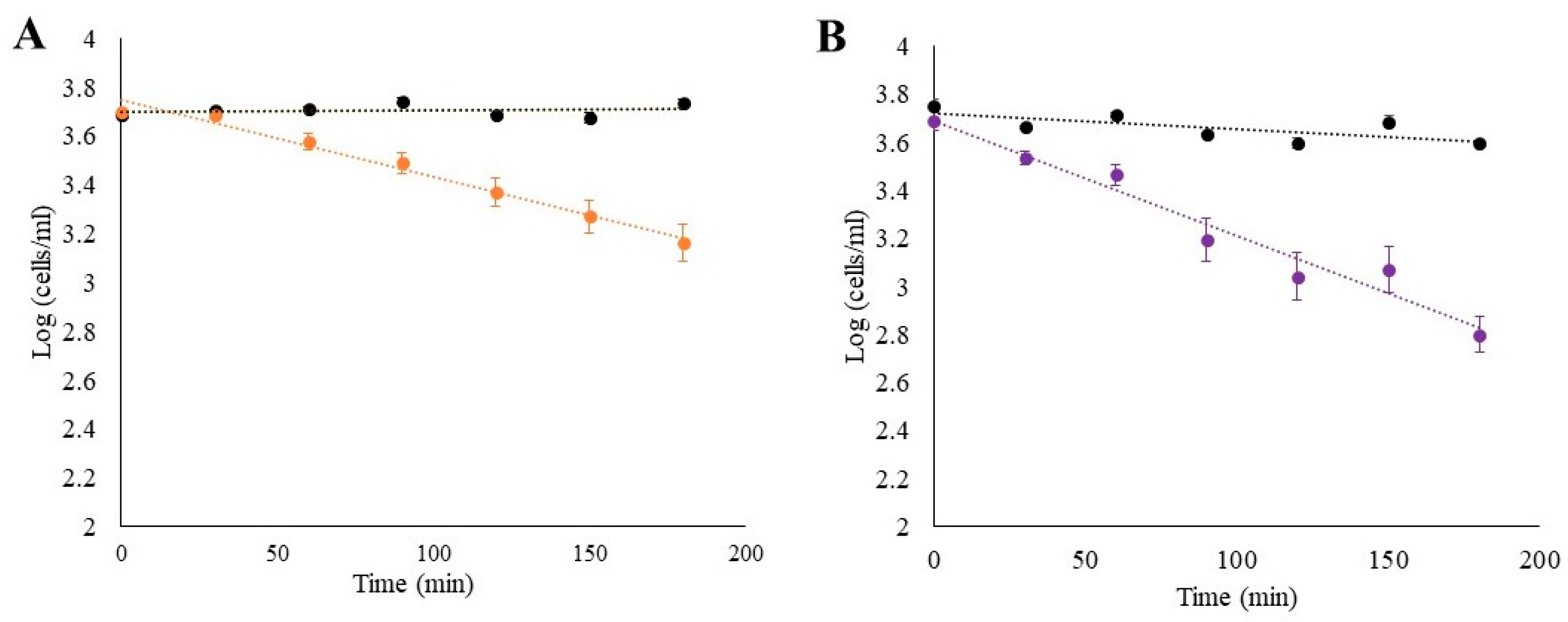
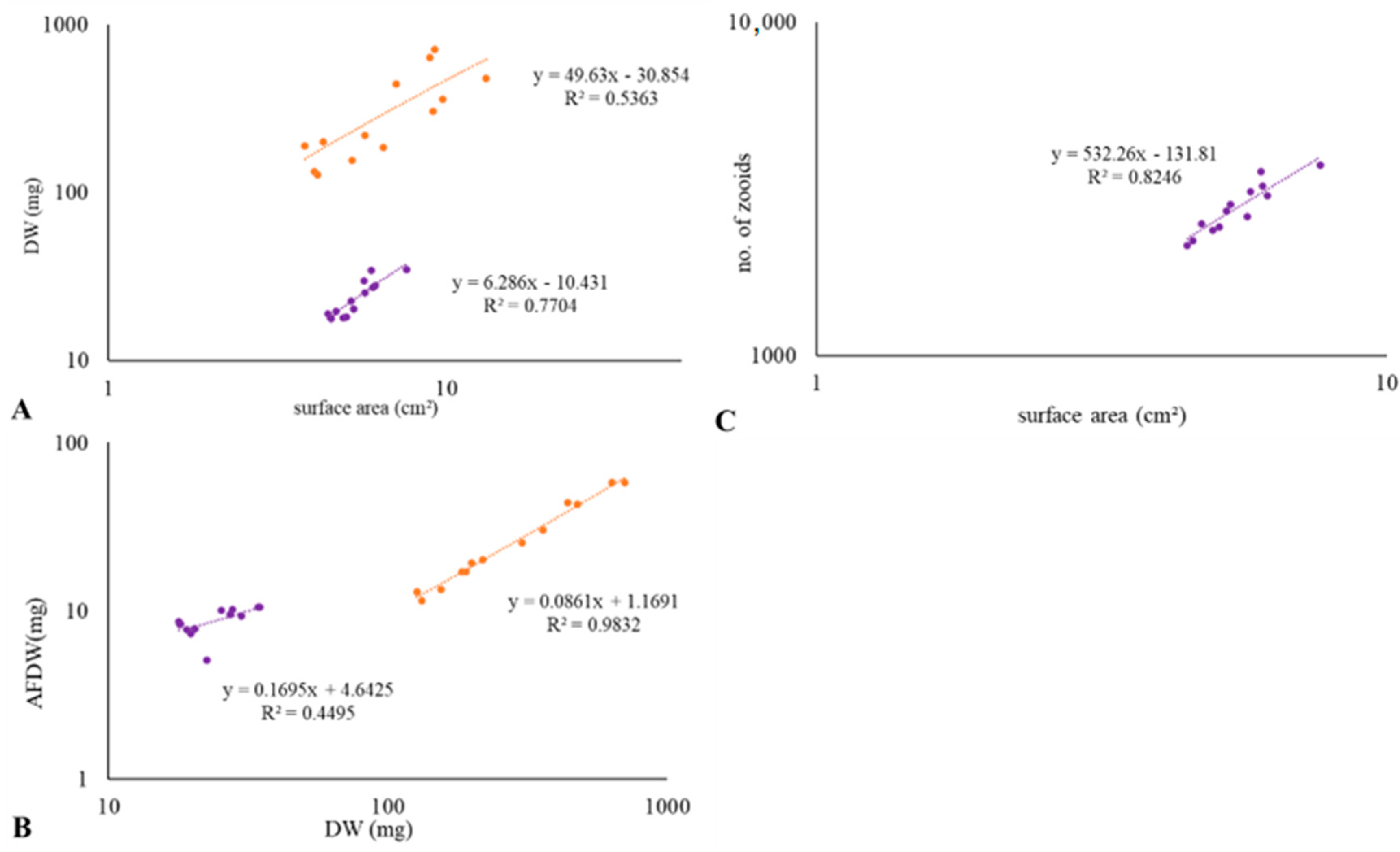
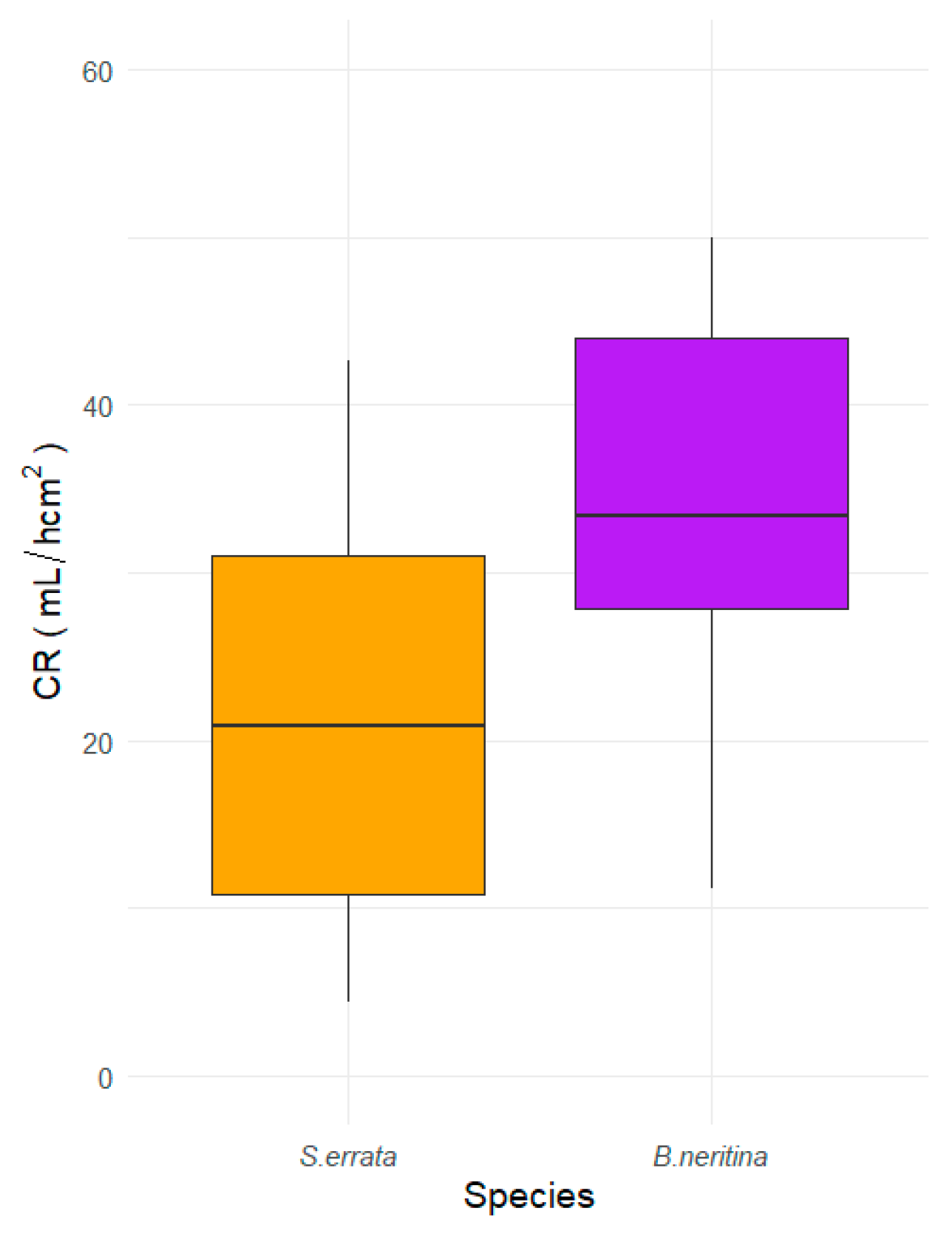
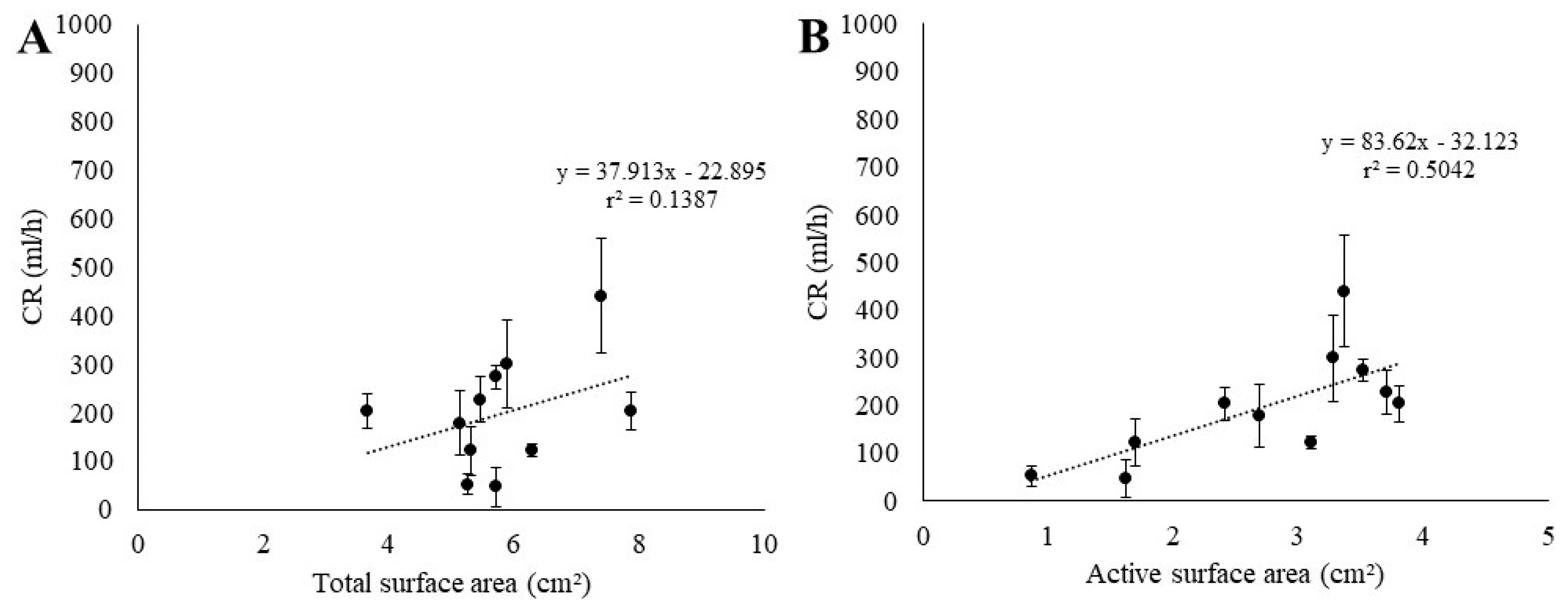
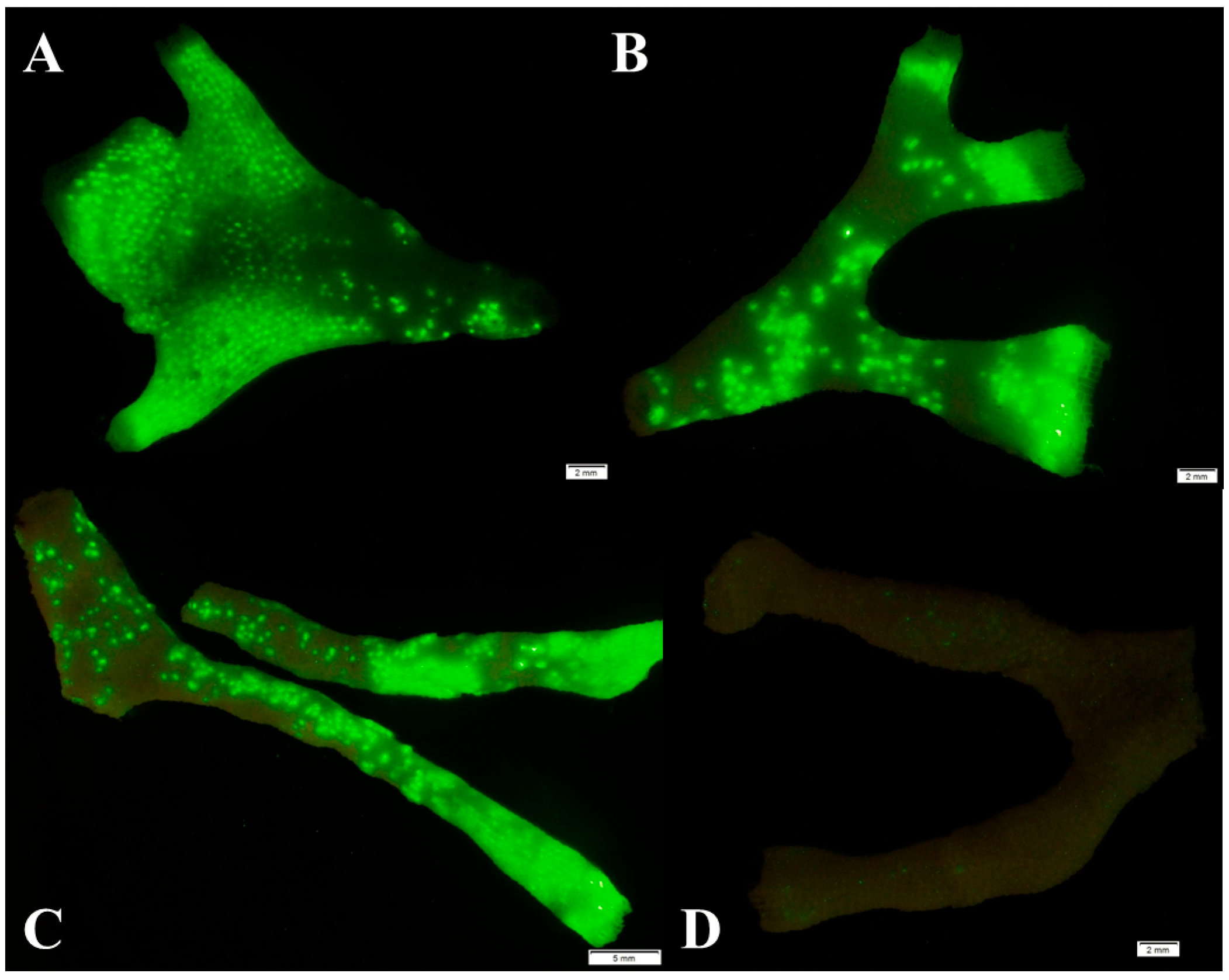
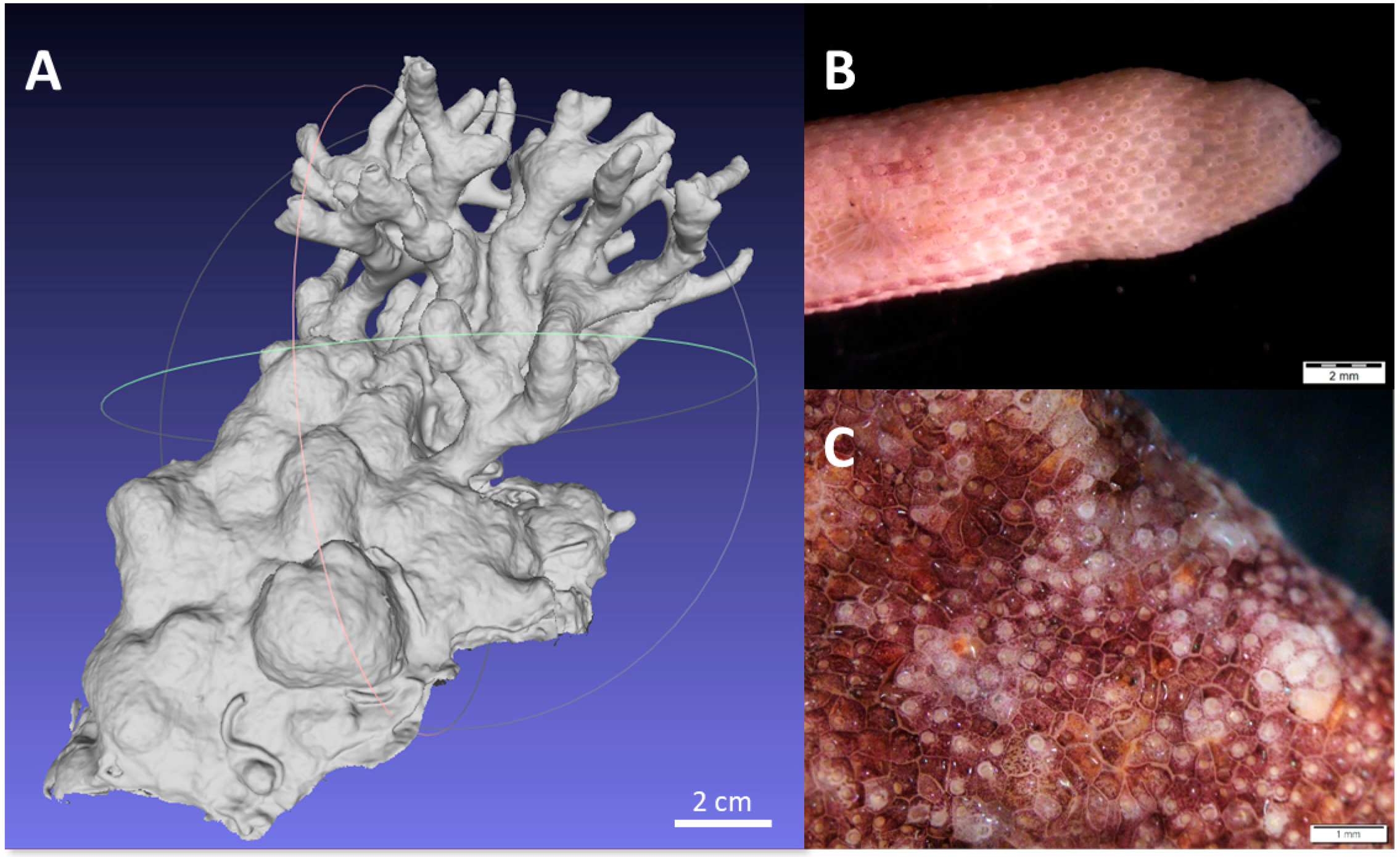
| Schizoporella errata | Bugula neritina | |
|---|---|---|
| CRmax/DW | 0.86 ± 0.34 L/(h·g) | 12.37 ± 3.66 L/(h·g) |
| CRmax/AFDW | 9.38 ± 3.65 L/(h·g) | 35.85 ± 15.13 L/(h·g) |
| CRmax/total surface area | 32 ± 10 mL/(h·cm2) | 52 ± 15 mL/(h·cm2) |
| CRmax/zooid | 0.05 ± 0.02 mL/(h·zooid) | 0.10 ± 0.03 mL/(h·zooid) |
| No. autozooids/cm2 | 575 | 535 |
Disclaimer/Publisher’s Note: The statements, opinions and data contained in all publications are solely those of the individual author(s) and contributor(s) and not of MDPI and/or the editor(s). MDPI and/or the editor(s) disclaim responsibility for any injury to people or property resulting from any ideas, methods, instructions or products referred to in the content. |
© 2025 by the authors. Licensee MDPI, Basel, Switzerland. This article is an open access article distributed under the terms and conditions of the Creative Commons Attribution (CC BY) license (https://creativecommons.org/licenses/by/4.0/).
Share and Cite
Fortič, A.; Mavrič, B.; Slavinec, P.; Lipej, L. The Overlooked Suspension Feeders: The Filtering Activity of the Bryozoans Schizoporella errata and Bugula neritina in the Northern Adriatic. J. Mar. Sci. Eng. 2025, 13, 1052. https://doi.org/10.3390/jmse13061052
Fortič A, Mavrič B, Slavinec P, Lipej L. The Overlooked Suspension Feeders: The Filtering Activity of the Bryozoans Schizoporella errata and Bugula neritina in the Northern Adriatic. Journal of Marine Science and Engineering. 2025; 13(6):1052. https://doi.org/10.3390/jmse13061052
Chicago/Turabian StyleFortič, Ana, Borut Mavrič, Petra Slavinec, and Lovrenc Lipej. 2025. "The Overlooked Suspension Feeders: The Filtering Activity of the Bryozoans Schizoporella errata and Bugula neritina in the Northern Adriatic" Journal of Marine Science and Engineering 13, no. 6: 1052. https://doi.org/10.3390/jmse13061052
APA StyleFortič, A., Mavrič, B., Slavinec, P., & Lipej, L. (2025). The Overlooked Suspension Feeders: The Filtering Activity of the Bryozoans Schizoporella errata and Bugula neritina in the Northern Adriatic. Journal of Marine Science and Engineering, 13(6), 1052. https://doi.org/10.3390/jmse13061052






